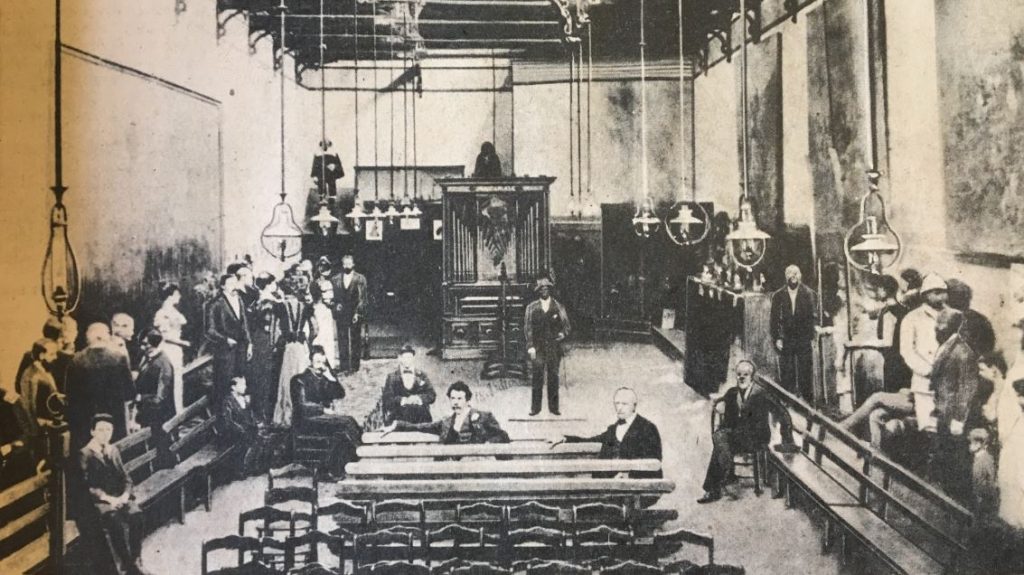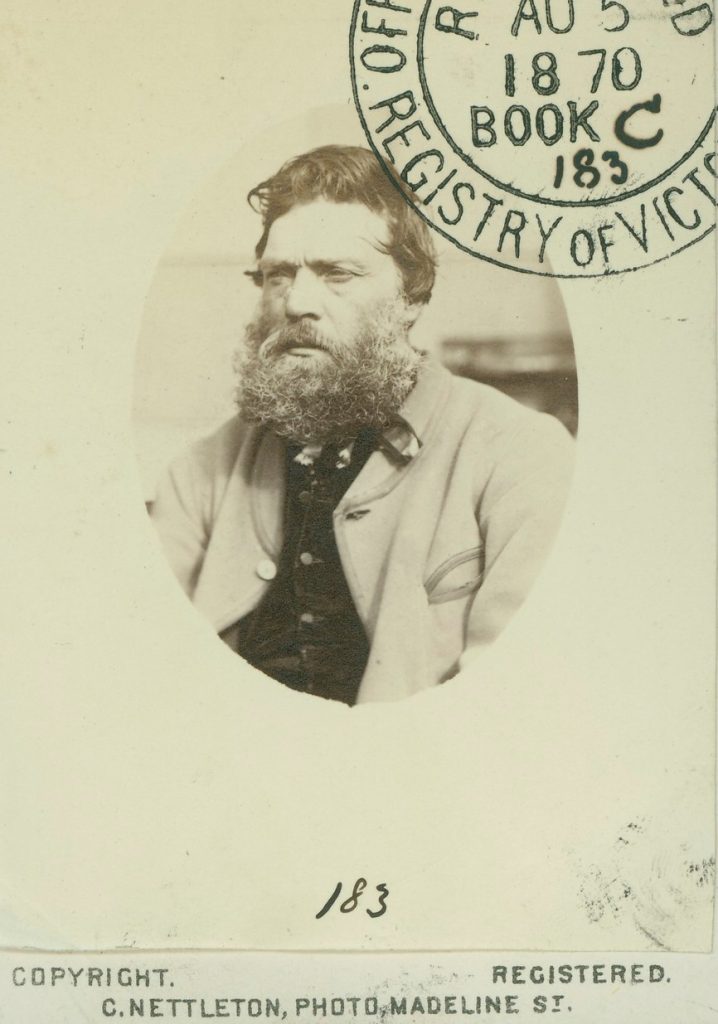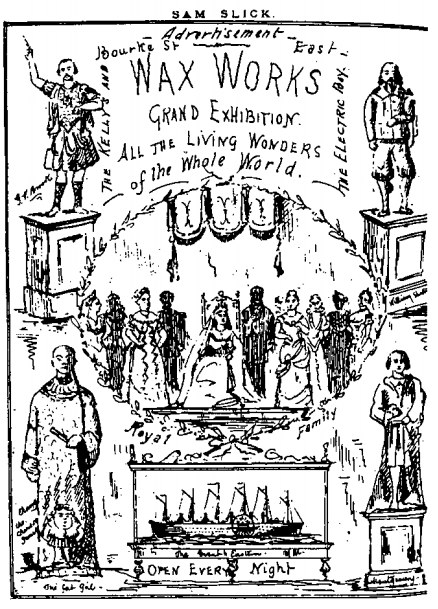‘The advertisements state truly that “everybody goes to the Waxworks” and judging by the crowds that are constantly undergoing the process of ingress and egress … one can readily believe, not only that everybody goes, but that everybody goes more than once.’ [1]
At the waxworks, 1876; A/S23/12/76/148
The Melbourne waxworks was a wildly popular institution for over half a century. Like it’s famous London counterpart – Madame Tussaud’s wax museum (est 1835) – the Melbourne waxworks walked the line between ‘instructive entertainment’ and sensationalism. It displayed wax models of historical and current figures both international and local, sometimes to amusing effect:
‘Distinctions of social rank or of moral qualities are, however, totally ignored. Thus we have the Bearded Lady looking benevolently upon Mr John Pascoe Fawkner, who, by the way, seems from his expression of countenance, by no means impressed with the compliment.’ [3]
The waxworks final location being between the Melbourne Coffee Palace and Parer’s Crystal Cafe. Bourke Street, north side between Russell and Swanston Streets, (circa 1888); H81.111
Wax figures included members of royalty, Napoleon, the Pope (wearing robes made by the nuns at the Abbotsford Convent), Voltaire, and Shakespeare. New figures were constantly added to keep up with current events. A life-size tableau of the explorers Burke and Wills (and King) was among one of the many figures on display, and appeared with astonishing speed, within weeks of news breaking about the ill-fated Victorian Exploration Expedition. [4]
Burke and Wills wax diorama at the waxworks from 1862; H2011.8

The main front hall of the waxworks towards the end of the 19th century. All of the standing figures are wax. (The Argus, 10 June 1939, p.3.)
What tended to hold the most fascination was the Chamber of Horrors with its likenesses of notorious criminals and scenes of torture. Much of the appeal was purely salacious, but it was also presented as a form of moral instruction – examples of ‘what may happen to a boy in Victoria’. [5]
Waxwork owner Mrs Sohier, an artist modeller, made copies from plaster casts that her husband, the phrenologist Philemon Sohier, had taken of the skulls of hanged criminals. Their combined efforts swelled the ranks of the aptly named Chamber of Horrors in the waxworks, which captured the morbid curiosity of the public.
‘The waxworks is a colonial industry; the more murderers, the more it thrives. The manufacturer always keeps a lot of bodies on hand, and immediately upon a malefactor being hanged pops a head upon one of them, advertises it, and in rush the public.’ [6]
Sam Slick in Victoria, 6 November 1879
A young Marcus Clarke described his waxworks visit in 1865 with lurid detail:
‘In one corner poor Burke and Wills, the explorers, lie in the agonies of death … There lies the figure of a man with his head split open and bleeding and his murderer “with the fatal pickaxe yet in his hands”, stands calmly by, two Chinamen, the perpetrators of the deed, leering with a sardonic grin on their waxen faces over tile couch and the blood “as natural as can be in red sealing wax a-running all over the counterpane”. ‘[7]
Marcus Clarke at 20, H81.204/2
Death as a type of spectacle was of course nothing new. People in the Victorian period were much more likely to have first-hand and intimate experience of death, and therefore had a much more circumspect attitude to it than we do today. In the same way we devour true crime books, podcasts about serial killers, and Tarantino movies, a visit to the waxworks was the closest way to have a one-on-one encounter with an infamous criminal. It was an early form of what we now call ‘dark tourism’. As Sally Prior has observed: ‘Victorians, like us, had an appetite for violence. [These days] it’s just been repackaged.’ [8]
Max Kreitmayer
In 1869 the Sohiers passed the baton to Ludwig Maximilian Kreitmayer (1830-1906), who had co-managed a Phrenology Museum with Philemon Sohier, and it was under his management that the waxworks would reach its most popular heights.
Kreitmayer’s entrepreneurial drive made him very proactive in his acquisition of new ‘faces’ for his increasingly lucrative gallery of horrors. When news of the siege of Glenrowan broke in 1880, Kreitmayer made a beeline to Benalla Prison, where by candlelight he made a death mask of the deceased Kelly gang member Joe Byrne. [9] Two days later it had been added to the waxworks’ collection of notorious bushrangers. [10]
Kreitmayer also made a death mask of Ned Kelly after his execution on 11 November 1880, a cast of which is held by the Library. Again, within days of Kelly’s execution the death mask was on public display. The Kelly gang tableau was so popular that Ned’s clothing and boots were periodically stolen, leading to Ned’s boots being nailed to the floor. [11]
Death mask of Ned Kelly made by Maximillian Kreitmayer, H2001.241
Kreitmayer’s 1912 exhibition catalogue lists a number of nefarious murderers on exhibit, including Martha Needle and Frederick Bailey Deeming, who were both executed at the Melbourne Gaol.
Despite the grim nature of the waxworks and its Chamber of Horrors, amusing stories abound:
‘Sitting to rest on a bench near the Royal family, a stout elderly woman had, I found, dropped asleep on the end of the same bench, in a most uncomfortable attitude. I was debating whether or not to awaken her, when a group of people coming up, to my intense amusement, took her for a wax figure. Her face, her figure, and even a large basket at her side were all criticised, and it was only when a slight pull at her dress by one of them woke her their illusion was dispelled, and they moved away, seeming somewhat discomfited.’ [12]
There was at least one live individual who was not impressed with his likeness:
‘One of the first things a recently discharged criminal did, on being released from Pentridge was to visit the Waxworks and remonstrate with Kreitmeyer upon the hideous effigy of him that was exhibited in the Waxworks. He threatened, if it was not removed and replaced by a better one, to “chuck it out himself”. Kreitmeyer managed to pacify him and promised to do a new figure and make it quite up to date.’ [14]
Table Talk names the criminal as none other than Harry Power, Ned Kelly’s one-time mentor:
“…he told Mr. Kreitmayer he was not satisfied, and asked permission to bring a proper suit of clothes. This was accordingly granted, and the curious spectacle was to be seen of Power in flesh and blood helping to attire Power in wax and sawdust.” [15]
 Power the Bushranger, H96.160/1579
Power the Bushranger, H96.160/1579
When Kreitmayer died in 1906 his widow Harriet continued managing the the business. From around 1911 the waxworks was replaced with a cinema, later to be called the Star. [16]
The story of the Waxworks continues with part 2: sideshow magic and living curiosities.
Sources:
[1] Bell’s Life in Victoria and Sporting Chronicle, 6 February 1864, p.2.
[2] The Australasian Sketcher with Pen and Pencil, December 23 1876, p.150.
[3] Herald Sun, 31 December 1863, p.2.
[4] The Argus, 13 January 1862, p.4.
[5] Melbourne Punch, 11 September 1873, p.2.
[6] Melbourne Punch, 6 June 1867, p.6.
[7] Cited from Mimi Colligan, “Waxworks shows and some of their proprietors in Australia, 1850s-1910s”, Australasian Drama Studies, Apr 1, 1999, Vol.34, p.91. Available in print, or online to Victorian registered library members.
Excerpt originally from Cyril Hopkins. ‘Biographical Notice of the Life and Work of Marcus Clarke’, MSS, Mitchell Library, SLNSW, pp. 30-31.
[8] Sally Prior, “Death and the macabre at Sideshow Alley at the National Portrait Gallery“, Sydney Morning Herald, 22 January 2016.
[9] Sideshow alley : infamy, the macabre & the portrait / Joanna Gilmour, p.110.
[10] Hamilton Spectator, July 3 1880, p.4
[11] The Herald, December 2 1939, p.9.
[12] The Herald, January 10 1880, p.3.
[13] Table Talk, December 13 1889, p.3.
[14] Free Lance, April 23 1896, p.7.
[15] Table Talk, December 13 1889, p.3.
[16] Public Opinion, January 21 1915, p.8.
[17] The Argus Weekend magazine, June 10 1939, p.3.
Further Reading:
Mimi Colligan, “Waxworks shows and some of their proprietors in Australia, 1850s-1910s”, Australasian Drama Studies, Apr 1, 1999, Vol.34, pp.86-107. Available in print, or online to Victorian registered library members.
Mimi Colligan, “Anatomical wax museums in Melbourne 1861 to 1887”, Australian Cultural History, no.13, 1994: (52)-64. Available in print.
Mimi Colligan, Canvas and wax : images of information in Australian panoramas and waxworks, with particular reference to Melbourne 1849- 1920. Monash University. Thesis 1987. Available from the Monash University Research Repository.
Mimi Colligan, ‘Kreitmayer, Maximilian Ludwig (Max) (1830–1906)’, Australian Dictionary of Biography, National Centre of Biography, Australian National University.
Jill Dimond, “Ned Kelly’s skull: a 133-year-old mystery”, Overland, No. 211, Winter 2013: 12-21.
Sideshow alley : infamy, the macabre & the portrait / Joanna Gilmour.
Accompanying online exhibition, National Portrait Gallery of Australia: https://www.portrait.gov.au/exhibitions/sideshow-alley-2015
Waxworks programs
You may also like
The marvellous and macabre Waxworks, part two: sideshow magic and human curiosities
Ask a Librarian
Direct from the State Library Victoria reference desk – our librarians share stories, resources and research tips, as well as some of their favourite queries (as asked by you!).
See more of our videos on our YouTube channel.
Images in Waxworks video by order of appearance:
- At the waxworks, 1876 A/S23/12/76/148.
- Bourke Street, north side between Russell and Swanston Streets (circa 1888), H81.111.
- Waxworks advertisement, Sam Slick in Victoria, 6 November 1879.
- “At the waxworks and museum”, Melbourne Punch, 16 April 1891, p 7.
- “Thrills and chills in the waxworks”, The Argus 10 June 1939, p. 3.
- “The Waxworks show that startled Melbourne”, Sporting Globe, 21 October, 1939 p. 7.
- “At the waxworks”, Sydney Punch, 22 August, 1873, p. 10.
- “Thrills and chills in the waxworks”, The Argus, 10 June 1939, p.3.
- Death mask of Ned Kelly made by Maximillian Kreitmayer, H2001.241.
- Marcus Clarke at 20, H81.204/2.
- Burke and Wills wax diorama at the waxworks from 1862, H2011.8.
- Barbarous murder in Little-Lonsdale-St, PN21/04/77/00.
- Death mask and cast of hand of Frederick Bayley Deeming, Accession no: H29467, H29468.
- “The atrocities at Windsor and Rainhill”, The Herald, 2 April 1892, p. 1.
- Image of Martha Needle, MS 8296.
- Rough on Rats – https://blogs.slv.vic.gov.au/such-was-life/martha-needle-melbournes-19th-century-serial-poisoner/
- “The Richmond poisoning case”, The Sydney Morning Herald, 26 September 1894, p. 5.
- At the waxworks, 1876, A/S23/12/76/148.
- Bourke Street, north side between Russell and Swanston Streets (circa 1888), H81.111.
- Parer’s Crystal Cafe [200 Bourke Street], H39357/126.
- Atlas & Vulcana, H93.406/15.
- A chorusline of 8 dancers and a principal girl, H90.108/138.
- “Jack the fighting kangaroo”, Melbourne Punch, 16 April 1891, p 7.
- H. S. Lynn, magician, H88.50/5.
- Amphitrite – Afternoon & evening daily, Waxworks poster, H2000.180/59.
- Magic: stage illusions and scientific diversions including trick photography
- Magic: stage illusions and scientific diversions including trick photography
Sound effects (People talking, Eerie, Circus, Applause, Water flowing in underground cave) courtesy of freesfx.co.uk





Creepy but so interesting! Good work writing this article
Thank you Gabriela – I’m glad you enjoyed the blog! Kylie
I remember visiting the old Melbourne gaol with my grandmother when she came face to face with the death mask of one of her (and mines,) relatives. I don’t know if its still there but this article has made me interested to go and see. Thank-you, I look forward to part 2.
Hi Megan, thank you for reading. Glad you found it interesting! I’m sure there are lots of great records you could find about your ancestor like criminal registers on the Public Records Office Victoria website, or newspapers on Trove. Also have a look our our Researching your Victorian Ancestors research guide. Kylie